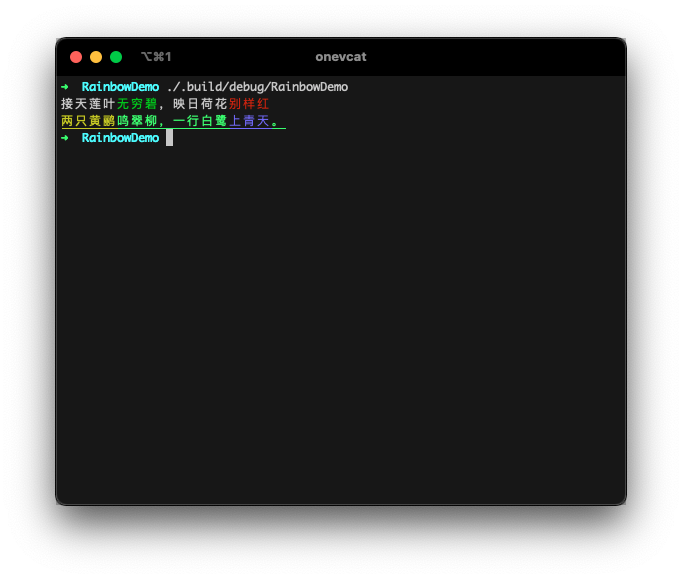Rainbow adds text color, background color and style for console and command line output in Swift. It is born for cross-platform software logging in terminals, working in both Apple's platforms and Linux.
Basic Usage
Nifty way, using the String extension, and print the colorized string.
Named Color & Style
import Rainbow
print("Red text".red)
print("Blue background".onBlue)
print("Light green text on white background".lightGreen.onWhite)
print("Underline".underline)
print("Cyan with bold and blinking".cyan.bold.blink)
print("Plain text".red.onYellow.bold.clearColor.clearBackgroundColor.clearStyles)
It gives you something like this:
Installation
Swift Package Manager
If you are developing a cross platform software in Swift, Swift Package Manager might be your choice for package management. Just add the url of this repo to your Package.swift file as a dependency:
import PackageDescription
let package = Package(
name: "YourAwesomeSoftware",
dependencies: [
.package(url: "https://github.com/onevcat/Rainbow", .upToNextMajor(from: "4.0.0"))
],
targets: [
.target(
name: "MyApp",
dependencies: ["Rainbow"]
)
]
)
Then run swift build whenever you get prepared.
You could know more information on how to use Swift Package Manager in Apple's official page.
Other Usage
String Interpolation & Nested
Swift string interpolation is supported. Define the color for part of the string. Or even create nested colorful strings. The inner color style will be kept:
print("接天莲叶\("无穷碧".green),映日荷花\("别样红".red)")
print("\("两只黄鹂".yellow)鸣翠柳,一行白鹭\("上青天".lightBlue)。".lightGreen.underline)
ANSI 256-Color Mode
8-bit color is fully supported, for both text color and background color:
print("停车坐爱\("枫林晚".bit8(31)),\("霜叶".bit8(160))红于\("二月花".bit8(198))。")
print("\("一道残阳".bit8(202))铺水中,\("半江瑟瑟".bit8(30).onBit8(226))半江红。")
Hex Colors (approximated)
It also accepts a Hex color. Rainbow tries to convert it to a most approximate .bit8 color:
print("黑云压城\("城欲摧".hex("#666")),甲光向日\("金鳞开".hex("000000").onHex("#E6B422"))。")
print("日出江花\("红胜火".hex(0xd11a2d)),春来江水\("绿如蓝".hex(0x10aec2))")
Valid format:
"FFF","#FFF","FFFFFF","#FFFFFF",0xFFFFFF
True color
A few terminal emulators supports 24-bit true color. If you are sure the 24-bit colors can be displayed in your user's terminal, Rainbow has no reason to refuse them!
print("疏影横斜\("水清浅".bit24(36,116,181)),暗香浮动\("月黄昏".bit24(254,215,26))")
print("\("春色满园".hex("#ea517f", to: .bit24))关不住,\("一枝红杏".hex("#f43e06", to: .bit24))出墙来。")
Output Target
By default, Rainbow should be smart enough to detect the output target, to determine if it is a tty. For example, it automatically output plain text if written to a file:
// main.swift
print("Hello Rainbow".red)
$ .build/debug/RainbowDemo > output.txt
// output.txt
Hello Rainbow
This is useful for sharing the same code for logging to console and to a log file.
You can manually change this behavior by either:
- Set the
Rainbow.outputTargetyourself. - Pass a
"NO_COLOR"environment value when executing your app. - Or set the
Rainbow.enabledtofalse.
Verbose Way
You can also use the more verbose way if you want:
import Rainbow
let output = "The quick brown fox jumps over the lazy dog"
.applyingCodes(Color.red, BackgroundColor.yellow, Style.bold)
print(output) // Red text on yellow, bold of course :)
Or even construct everything from scratch:
let entry = Rainbow.Entry(
segments: [
.init(text: "Hello ", color: .named(.magenta)),
.init(text: "Rainbow", color: .bit8(214), backgroundColor: .named(.lightBlue), styles: [.underline]),
]
)
print(Rainbow.generateString(for: entry))
Please remember, the string extensions (such as "Hello".red) is O(n). So if you are handling a huge string or very complex nesting, there might be a performance issue or hard to make things in stream. The manual way is a rescue for these cases.
Motivation and Compatibility
Thanks to the open source of Swift, developers now could write cross platform programs with the same language. And I believe the command line software would be the next great platform for Swift. Colorful and well-organized output always helps us to understand what happens. It is really a necessary utility to create wonderful software.
Rainbow should work well in both OS X and Linux terminals. It is smart enough to check whether the output is connected to a valid text terminal or not, to decide the log should be modified or not. This could be useful when you want to send your log to a file instead to console.
Contact
Follow and contact me on Twitter or Sina Weibo. If you find an issue, just open a ticket on it. Pull requests are warmly welcome as well.
Backers & Sponsors
Open-source projects cannot live long without your help. If you find Kingfisher is useful, please consider supporting this project by becoming a sponsor. Your user icon or company logo shows up on my blog with a link to your home page.
Become a sponsor through GitHub Sponsors.
License
Rainbow is released under the MIT license. See LICENSE for details.















